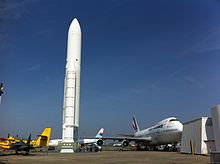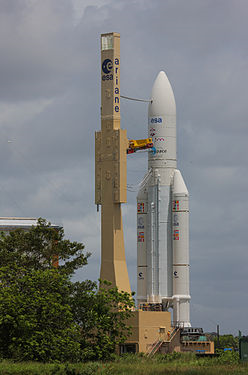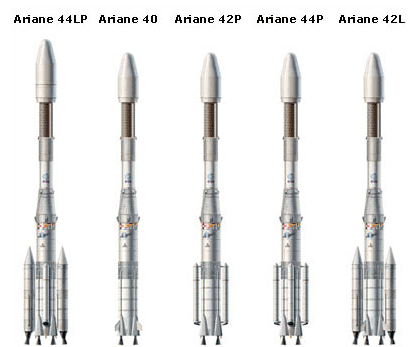Ariane Rockets are a series of European launch vehicles that are used to propel satellites and cargo into space. They are reliable and versatile making them among the world’s premier commercial satellite launchers.

The Ariane Project was first proposed by France but was not officially accepted until the end of 1973 after discussions between France, Germany and UK. It was the second effort by Western Europe to develop its own space launcher vehicles after the unsuccessful Europa project.
EADS Astrium develops the launchers and provides testing facilities. Arianespace is in charge of production, operations and marketing.
The Ariane Launch Facilities are known as ELA. The first ELA was originally designed for Europa vehicle but was used for Ariane 1, 2 and 3. Arianespace launches Ariane 5 rockets from the Centre Spatial Guyanais in French Guiana mainly because the proximity to the equator provides favorable conditions for the launches.
Ariane Rockets History
Ariane 1
Ariane 1 was a three-stage launcher with a payload capacity of 1800kg. The first stage was propelled by four Viking rockets while the second stage was propelled by a single Viking engine.
The first Ariane 1 rocket flew on 24 December 1979. In total, there were eleven Ariane 1 launches in the period between 1979 and 1986 placing 14 payloads into geostationary orbits. The Giotto space probe launched on 2 July 1985 that flew by Halley’s Comet on 13 March 1986 was an Ariane 1 payload.
A Photo of Ariane 1 Launching Giotto Space Probe Image Source
Ariane 2
Ariane 2 was the second development of Ariane rockets. Its launch configuration was similar to that of Araine 1 except that Ariane 2 did not have strap-on boosters. There were six Ariane 2 rockets launches with the first occurring on 31 May 1986 and the last on 2 April 1989. There were only five Ariane 2 payloads.
Ariane 3
Ariane 3 was like an extended second version of Araine rockets. Compared to Ariane 1, Ariane 3 rockets had 150% more payload, a larger third stage, more payload fairing and two solid boosters for increased performance.
The first Ariane 3 flight was on 4 August 1984 while the last happened on 12 July 1989. In total, there were 11 Araine 3 flights and 19 payloads.
Ariane 4
Araine 4 rockets had increased capability than Araine 2 and 3 and featured an improved design where the first stage propellants were stretched. There were six configurations of the launcher and performance could be optimized for a specific payload by adding liquid, solid or mixed strap-on boosters.
An Ariane 40 did not have any strap-on booster, an Araine 42L had two liquid boosters, a 42P had two solid boosters while a 44LP had two solid and two liquid boosters. An Ariane 44L had the most powerful configuration consisting of four liquid boosters.
There were 116 Araine 4 missions in total delivering 182 payloads into space among them communication satellites. The first Araine 4 flight was in June 1988 and the last in February 2003. An Araine 44P launched the Infrared Space Observatory (ISO) in November 1995.
Some of Ariane 4 Versions Image Source
Araine 5
Araine 5 is the current launch vehicle in the Araine family of rockets. It is a heavy lift launcher used to launch commercial satellites and European Space Agency (ESA) science projects into space. The first Araine 5 rocket launched on 4 June 1996 encountered control problems after a power failure and had to be destroyed. Despite this initial failure, the Araine 5 family of rockets has proven to be very successful, cost efficient and reliable and is expected to be in use until at least 2015.
While Ariane 2, 3 and 4 were an improvement of the basic vehicle with increased payloads, Araine 5 was almost a complete redesign. It has a simple and robust architecture with a strengthened main cryogenic stage propelled by a Vulcain 2 engine, two solid booster stages and a storage propellant upper stage.
Araine 5 payload capacity enables a payload launch of any size. One remarkable Araine 5 payload is the European Automated Transfer Vehicle (ATV) that transports cargo and fuel to the International Space Station. There are also several large Ariane 5 astronomical observatories launches including the XMM-Newton Telescope, Herschel Telescope and the Planck Microwave Observatory.
 A Photo of Ariane 5 with ATV-4 on Board Image Source
A Photo of Ariane 5 with ATV-4 on Board Image Source
The Future of Ariane Rockets
Germany and French differed in their visions of the future of Araine Rockets. Germany wanted to develop Ariane 5 ME (Midlife Evolution), an upgrade of Araine 5 while France wanted to develop a next generation Ariane 6.
The Berlin Paris compromise gave a go ahead to both Germany and France to go ahead with their planned developments. Germany’s Ariane 5 ME will have a new cryogenic upper stage, which will be powered by the new Vinci Engine and will provide increased Geostationary Transfer Orbit payload of up to 12 tonnes on dual launches. In comparison, French’s Ariane 6 will have a smaller payload capacity but is expected to be more competitive.


